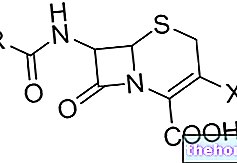Definition
Among the sleep disorders, that of sleep apnea is a real torment: also known as obstructive sleep apnea syndrome, the problem essentially consists in the obstruction of the upper airways during inspiration, which results in a reduction or (temporary) stopping of the flow of air into the lungs.
Causes
Sleep apnea occurs when the muscles located behind the throat relax: in these circumstances, the airways narrow during inspiration, with temporary blocking of breathing.
- Risk factors: mandibular abnormalities, CNS relaxing drugs, tongue enlargement, hypertrophy of the tonsils and adenoids, thickening of the soft tissue surrounding the airways, acute mononucleosis, obesity, weak muscle tone
Symptoms
↓ alveolar ventilation → ↑ blood pressure and carbon dioxide → poor quality sleep and not very restful
The intensity and duration of sleep apnea are subjective; in general, the most recurrent Symptoms are: dry mouth (upon awakening), difficulty in staying asleep, excessive daytime sleepiness, hypersomnia, sore throat and headache (upon awakening), sudden awakenings during sleep with shortness of breath, snoring.
The information on Sleep Apnea - Drugs for the Treatment of Sleep Apnea is not intended to replace the direct relationship between health professional and patient. Always consult your doctor and / or specialist before taking Sleep Apnea - Drugs for the Treatment of Sleep Apnea.
Medicines
Sleep apnea is a slight disorder only in appearance: in fact, the risk of complications increases exaggeratedly when the episodes of sleep apnea become frequent and the time of interruption of breathing is rather long. Among the most alarming complications, cardiovascular disorders such as hypertension, stroke, atrial fibrillation and congestive heart failure stand out. Not to mention the risks faced by the patient suffering from sleep apnea following surgery, being more prone to respiratory problems; even the administration of some drugs can weigh on sleep apnea.
The main objective of therapy for sleep apnea is to improve the quality of sleep of the patient who is affected by it, thus avoiding all the consequences that could derive from it. Once again, the specific treatment must be personalized to the individual patient, according to the severity of symptoms and the underlying cause, for example, hypertrophy of the tonsils and adenoids in children can cause sleep apnea; generally, their surgical excision results in complete recovery from the nocturnal disturbance. In some affected patients the application of an oxygen mask is recommended, capable of creating a positive pressure inside the airways: it is a mini respirator (or ventilator) useful for keeping the airways open between the released muscles. Others require specific dental prostheses to push the jaw forward, especially patients subject to the relaxation of the neck muscles during night rest: the application of the prosthesis is indicated not only for the prevention of sleep apnea, but also for improve nocturnal breathing in some affected or at risk individuals.
Since sleep apneas are recurrent phenomena in obese people, it is recommended, in this case, to follow a low-calorie diet to reduce body weight (see: article on drugs for the treatment of obesity); among other rules of character in general, it is also recommended not to drink alcohol for 4-6 hours before bedtime, not to take sedative drugs and to stop smoking.
Now let's see what are the drugs used in therapy to alleviate the symptoms of sleep apnea.
The following are the classes of drugs most used in the therapy against sleep apnea, and some examples of pharmacological specialties; it is up to the doctor to choose the most suitable active ingredient and dosage for the patient, based on the severity of the disease, the state of health of the patient and his response to treatment:
First-line drugs for the treatment of sleep apnea
Most patients suffering from sleep apnea complain of an unpleasant feeling of having slept badly, with repercussions during the day: the subject, in fact, tends to suffer from drowsiness. When daytime lethargy becomes severe, it is sometimes advisable to administer stimulant drugs, such as amphetamine or anti-narcotics.
- Theophylline (eg. Aminomal Elisir, Diffumal, Respicur) just like caffeine, theophylline is a xanthine drug used in therapy also (and not only) for the treatment of sleep apnea, useful both to reduce the frequency of episodes and to alleviate them satellite symptoms, such as insomnia. Theophylline is also indicated for the treatment of sleep apnea in the newborn. As an alternative to theophylline, the newborn can be treated with oral administration of cafeine citrate (nymusa) at a dose of 10-20 mg / kg (maintenance dose: 5 mg / kg) Stop treatment with theophylline or caffeine after 7 days from the disappearance of symptoms.
- Modafinil (eg Provigil): the drug is a stimulant, indicated for the treatment of sleep disorders such as hypersomnia and narcolepsy in the context of sleep apnea; the active ingredient acts by promoting the release of neurotransmitters (monoamines), and by raising histamine levels in the hypothalamus. The drug should be taken at a dose ranging from 150 to 250 mg, once a day, preferably in the morning. The dose varies according to the the severity of the disorder: it is minimal in the case of mild hypersomnia and is highest when the disorder degenerates into full-fledged narcolepsy (if sleep apnea is a serious problem). mild forms of drowsiness, should not fall below 150 mg.
- Amphetamine and Dextroamphetamine (eg DextroStat, Adderall, Dexedrine): belong to the class of sympathomimetic amines, substances that stimulate the central nervous system. It is recommended to start therapy with a drug dose of 10 mg, to be taken orally, in the morning. If necessary, it is possible to correct the dosage for the maintenance phase, increasing by 10 mg every 7 days (not to exceed 60 mg per day), in addition to always dividing the dosages. This dose is typically considered for the treatment of narcolepsy. Lower dosages are indicated to treat moderate to moderate hypersomnia in the context of sleep apnea. The drug is also available as a slow-release capsule and oral solution. Consult your doctor.
See also: drugs for the treatment of hypersomnia
Please note: it must be emphasized again: sleep apnea is an important problem in the obese: therefore, weight reduction is essential to alleviate the respiratory problem, up to completely canceling it out when the ideal body weight is reached.
It is also advisable to abandon the supine position to sleep, preferring to the side: the implementation of this strategy seems to bring positive results on the problem of sleep apnea.























-nelle-carni-di-maiale.jpg)




